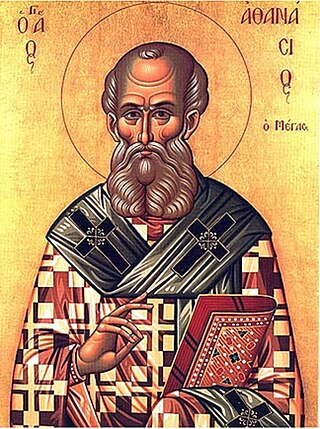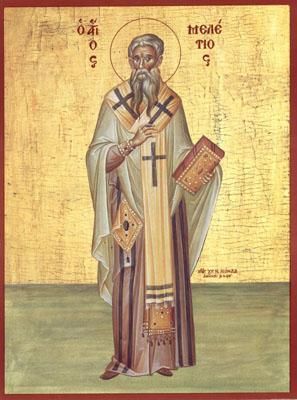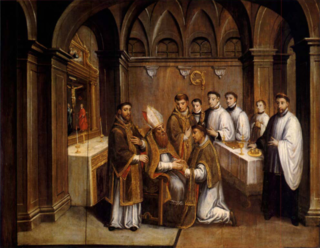Arianism is a Christological doctrine first attributed to Arius, a Christian presbyter who preached and studied in Alexandria, Egypt. Arian theology holds that Jesus Christ is the Son of God, who was begotten by God the Father with the difference that the Son of God did not always exist but was begotten/made before "time" by God the Father; therefore, Jesus was not coeternal with God the Father, but nonetheless Jesus began to exist outside time as time applies only to the creations of God.

Athanasius I of Alexandria, also called Athanasius the Great, Athanasius the Confessor, or, among Coptic Christians, Athanasius the Apostolic, was a Christian theologian and the 20th pope of Alexandria. His intermittent episcopacy spanned 45 years, of which over 17 encompassed five exiles, when he was replaced on the order of four different Roman emperors. Athanasius was a Church Father, the chief defender of Trinitarianism against Arianism, and a noted Egyptian Christian leader of the fourth century.

The First Council of Constantinople was a council of Christian bishops convened in Constantinople in AD 381 by the Roman Emperor Theodosius I. This second ecumenical council, an effort to attain consensus in the church through an assembly representing all of Christendom, except for the Western Church, confirmed the Nicene Creed, expanding the doctrine thereof to produce the Niceno-Constantinopolitan Creed, and dealt with sundry other matters. It met from May to July 381 in the Church of Hagia Irene and was affirmed as ecumenical in 451 at the Council of Chalcedon.

Gregory of Nazianzus, also known as Gregory the Theologian or Gregory Nazianzen, was a 4th-century Archbishop of Constantinople and theologian. He is widely considered the most accomplished rhetorical stylist of the patristic age. As a classically trained orator and philosopher, he infused Hellenism into the early church, establishing the paradigm of Byzantine theologians and church officials.
The 360s decade ran from January 1, 360, to December 31, 369.
The 330s decade ran from January 1, 330, to December 31, 339.
The 340s decade ran from January 1, 340, to December 31, 349.
Pope Liberius was the bishop of Rome from 17 May 352 until his death. According to the Catalogus Liberianus, he was consecrated on 22 May as the successor to Julius I. He is not mentioned as a saint in the Roman Martyrology. That makes him the earliest pontiff not to be venerated as a saint in the Catholic Church and, along with Anastasius II, one of only two popes to be omitted from Catholic sainthood in the first 500 years of church history.

Basil of Caesarea, also called Saint Basil the Great, was a bishop of Caesarea Mazaca in Cappadocia, Asia Minor. He was an influential theologian who supported the Nicene Creed and opposed the heresies of the early Christian church, fighting against both Arianism and the followers of Apollinaris of Laodicea. His ability to balance his theological convictions with his political connections made Basil a powerful advocate for the Nicene position.

Saint Meletius was a Christian bishop of Antioch from 360 until his death in 381. However, his episcopate was dominated by a schism, usually called the Meletian schism.

Paul I or Paulus I or Saint Paul the Confessor, was the sixth bishop of Constantinople, elected first in 337 AD. Paul became involved in the Arian controversy which drew in the Emperor of the West, Constans, and his counterpart in the East, his brother Constantius II. Paul was installed and deposed three times from the See of Constantinople between 337 and 351. He was murdered by strangulation during his third and final exile in Cappadocia. His feast day is on November 6.

Eusebius of Vercelli was a bishop from Sardinia and is counted a saint. Along with Athanasius, he affirmed the divinity of Jesus against Arianism.

Lucian of Antioch, known as Lucian the Martyr, was a Christian presbyter, theologian and martyr. He was noted for both his scholarship and ascetic piety.
Acacius of Caesarea was a Christian bishop probably originating from Syria; Acacius was the pupil and biographer of Eusebius and his successor on the see of Caesarea Palestina. Acacius is remembered chiefly for his bitter opposition to Cyril of Jerusalem and for the part he was afterwards enabled to play in the more acute stages of the Arian controversy. The Acacian theological movement is named after him. In the twenty-first oration of St. Gregory Nazianzen, the author speaks of Acacius as being "the tongue of the Arians".
Semi-Arianism was a position regarding the relationship between God the Father and the Son of God, adopted by some 4th-century Christians. Though the doctrine modified the teachings of Arianism, it still rejected the doctrine that Father, Son, and Holy Spirit are co-eternal, and of the same substance, or consubstantial, and was therefore considered to be heretical by many contemporary Christians.

Lucifer of Cagliari was a bishop of Cagliari in Sardinia known for his passionate opposition to Arianism. He is venerated as a Saint in Sardinia, though his status remains controversial.

Alexander I of Alexandria was the 19th Pope and Patriarch of Alexandria. During his patriarchate, he dealt with a number of issues facing the Church in that day. These included the dating of Easter, the actions of Meletius of Lycopolis, and the issue of greatest substance, Arianism. He was the leader of the opposition to Arianism at the First Council of Nicaea. He also mentored his successor, Athanasius of Alexandria, who would become one of the Church Fathers.
The Pneumatomachi, also known as Macedonians or Semi-Arians in Constantinople and the Tropici in Alexandria, were an anti-Nicene Creed sect which flourished in the regions adjacent to the Hellespont during the latter half of the fourth, and the beginning of the fifth centuries. They denied the godhood of the Holy Ghost, hence the Greek name Pneumatomachi or 'Combators against the Spirit'.

Paulinus II was a claimant to the See of Antioch from 362 to 388.











